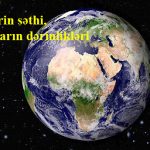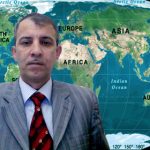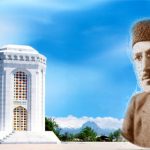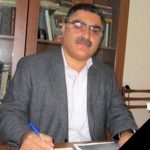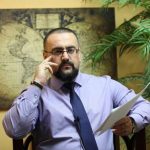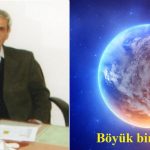Alonso Sanchez de Huelva and Christopher Columbus
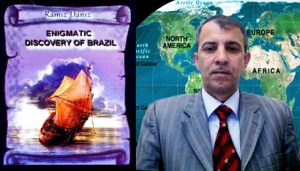
Theoretically, half of Floridian peninsula, Anthills, Mexico and South America became properties of Portugal. After “Aeterna Regis” came into force, historians began to note that, America had been discovered by Portuguese seamen before 1481 and this fact had been kept secret till the convenient time. This thought was defended by all annalists of XVI century – Bartolome de las Casas, Francisco Lopez de Gomara and Gonzalo Fernandez de Oviedo y Valdes, even Peruvian annalist Garcilaso de la Vega (son of the Ink prince and the hidalgo of Estrema-dura) mentioned name of Alonso Sanchez de Huelva as the seaman, who discovered the continent. Besides it, Jorje Blon, Francisco de Gomara Alonso and others noted that Huelva had met Columbus.
According to historical sources, Columbus travelled to Portugal for the next time in 1478 and settled in Madeira Islands for several years.
According to information given by the merchant and sea traveler of Venice Alvise Cadamosto, father-in-law of Columbus was well-known colonialist. Columbus could find several documents about different travels of Portuguesein the Atlantic Ocean. Those documents helped him in preparation of the project about the discovery of the western part of the mentioned ocean.
In 1484 Alonso Sanchez de Huelva, who was from the settlement of Niebla (Huelva), used to carry some goods from Spain to Canaries with his vessel. He carried fruits from Canaries to Madeira, then brought sugar and jam from Madeira to Spain. Ones Alonso Sanchez met with heavy hurricane when sailed from Canaries to Madeira. He sailed for about 28 or 29 days under the influence of that hurricane and approached an unknown island in the ocean. It is supposed that, that island was today’s Santo Domingo. People came to that conclusion as the hurricane (east wind) blew in the direction from Canaries to Solano.1
Ones a wrecked vessel approached the coast of Porto Santo. Columbus noticed one weakened navigator among survived seamen. One of seamen raved about songs of motley birds, unknown animals and colored people. The vessel had been sailing from the west and struck the coast. Christopher Columbus took half-dead navigator home.
He looked after his guest and it became clear that, navigator’s name was Alonso Sanchez de Huelva. After getting better, Alonso Sanchez explained everything that happened to them. It became clear that, they had lost their way in the dark sea (then Atlantic Ocean was called like that) and reached very charming island. Sanchez informed his liberator about the place where the island was situated.2 After it he died as other survived seamen of the wrecked vessel.3
According to Peruvian annalist Garcilaso de la Vega, historian Francisco Lopez de Gomara had written about the adventure of Alonso Sanchez de Huelva in his work “General history of India”. Son of the Ink prince caviled at that work as following: “De Gomara heard this information from ordinary persons – seamen and civil people, his father and father’s authoritative friends, including people, who were close to the palace”.
This adventure was told by the bishop Joseph Acosta for the first time. When he was in Peru, he heard that, one seaman had discovered coasts of the New World at the result of heavy hurricane and showed the way to Columbus as the Genoese seaman helped him after the catastrophe happened on the way to Madeira. Columbus told this story to some acquaintances including courtiers, and they helped him in organization of the expedition.4
Spanish monarchs had to keep promises if Columbus could discover coasts of the New World. Obstacles began to be put in the way of the Genoese seaman, who had demanded great concessions. Columbus could get those concessions partly. People, who were close to the palace, prepared intrigues against the seaman who had become admiral after the first travel.
Conquistadors noted that, America had been discovered by Alonso Sanchez (de Huelva – R.D.). It was said because there was an inheritance conflict between heirs of Columbus and leadership of Castilia at that time (1510-1550). That’s why courtiers tried to prove that, lands located on the other side of the ocean hadn’t been discovered by Christopher Columbus.5
Historians, who were against Columbus, noted that, II Juan wanted to entrust Sanchez with discovering those lands as he was in the west after surviving in the catastrophe. Columbus rendered the navigator harmless as he had prepared his own project for the discovery of places located in the west of the Atlantic Ocean and didn’t want any competitor in this work.
This thought is so preconceived because when seamen of the wrecked vessel approached the coast, there were a lot of people besides Christopher Columbus and explanations were made with participation of them. Peruvian annalist Garcilaso de la Vega, Francisco Lopez de Gomara and Jorje Blon didn’t want to deny services of Columbus when mentioned name of Huelva and noted that he had met the famous traveler. They only wanted to emphasize that, the Genoese seaman had got necessary information for realization of his transatlantic travel from Huelva. But as Columbus was very experienced navigator, he couldn’t believe in such unserious, inexact information. He was sure that, America was far from Madeira Islands and it was impossible to reach there without knowing coordinates. Alonso de Huelva might meet with any island – even with Green Cape Islands.
This strange thought can’t cast a shadow on the authority of Columbus. It was written in Garcilaso de la Vega’s book that, Alonso Sanchez sailed in an unknown direction for 28-29 days under the influence of the hurricane and approached Santo Domingo Island. How it was possible? It means that, the vessel, which was pushed towards the west, met with Gulfstream current and could run away from it easily. It isn’t convincing as in that case Portuguese could discover unknown lands located in the west of the Atlantic Ocean before the first travel of Columbus. Portuguese had sent there expeditions under the leadership of Vogado, Telles and Van Olmen, but none of those expeditions resulted in success.
Gulfstream current, which played the role of barrier in front of Big Anthill islands and Small Anthill islands, could take any vessel to Europe in the east of the Atlantic Ocean. It means that, the captain using North Passat blowing from east to west in the northern hemisphere wasn’t able to take his vessel to the Caribbean aquatory as the North Passat rises towards the north and unites with Gulfstream at that latitude of the Atlantic Ocean.
If information of Huelva had positive influence on the project of Christopher Columbus, the Genoese seaman could follow the North Passat current during his first travel as soon as he left European coasts, directly reach South American coasts and discover Brazil. As Columbus had sailed near coasts of Guinea before, he was aware of existence of that current.
Development of shipbuilding, navigation and geography resulted in achievement of great successes in the field of great geographical discoveries. There was need for experienced and skilful seamen for realization of long-distance travels. Columbus owned all those characteristics. He (Columbus – R. D.) had got systematical education and learned geography, cartography and navigation as the person, who was interested in everything… He had married with the daughter of the Portuguese seaman in Porto Santo Island, so could get sea maps and diaries of his father-in-law.6
Columbus had prepared for the transatlantic travel seriously unlike most candidates and could realize it successfully. He didn’t need Alonso de Huelva’s help. He had begun to work on his project before 1484 and didn’t want to change it. I had given detailed information about it in my work “The scientist passed ahead of centuries – Nasiraddin Tusi” and decidedly noted that, Columbus had used the astronomic catalogue “Zij-i Ilkhani” prepared by Nasiraddin Tusi in Maraga observatory.7
President grant holder on literature, laureate of the “Golden pen” award Ramiz Daniz
A piece from book Enigmatic discovery of Brazil


